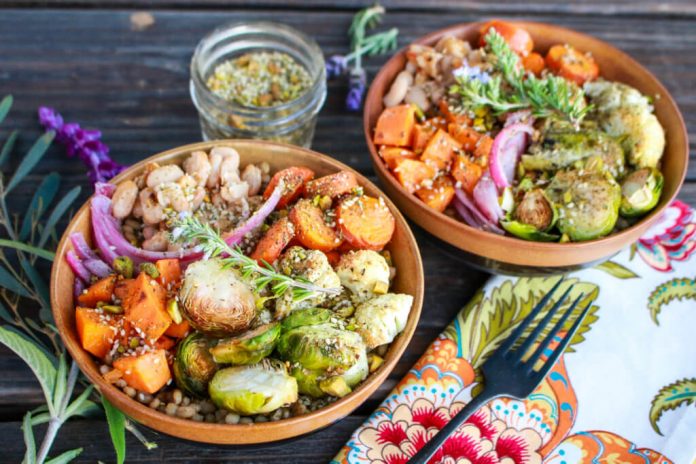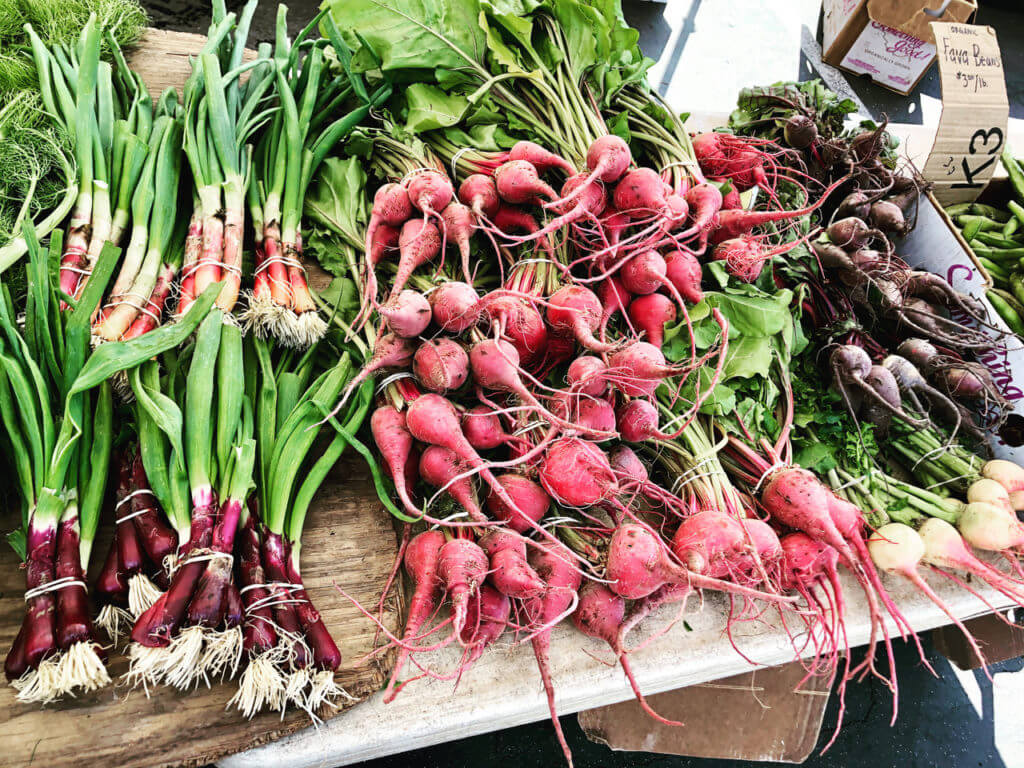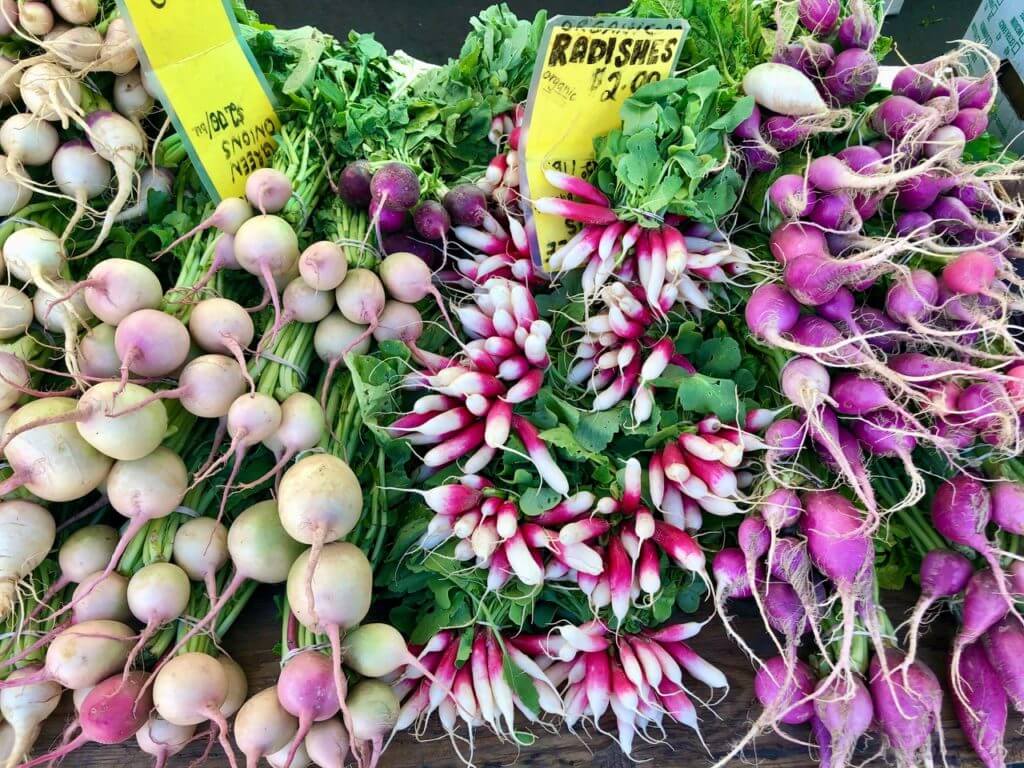A sustainable diet is filled with a diverse array of foods, plus it promotes biodiversity in our ecosystems. Learn more about how you can support biodiversity in your diet.
We “must not only produce enough calories to feed a growing global population, but must also produce a diversity of foods that nurture human health and support environmental sustainability”, Eat-Lancet Comission.1
That’s our mantra—we need to feed our population a nutritious diet, without further hurting our planet. And the term biodiversity is becoming more and more important in the world of sustainable food systems. You often hear the term “variety” in healthy diets, as in “focus on a variety of nutrient-dense foods.” It’s written in our nutrition canons, from the Dietary Guidelines for Americans to National Nutrition Month messages. Indeed, eating a variety of foods is one of the key things we can do for an optimal diet that supports human health. However, the word “variety” might be better traded for the term “diversity” today, as we explore the many facets related to diet quality, as well as their impacts on people and the planet.
Diversity opens up the diet conversation to not only include the array of nutrients found in high-quality diets, but also to explore the importance of biodiversity—the diversity of plants, animals and other organisms used for food, both cultivated and from the wild—in our diet patterns. “Biodiversity is at the base of healthy ecosystem services that provide us with clean water, air, and nutrient-rich foods for a healthy life,” says Chris Vogliano, MS, RDN, PhD Candidate and Global Health Consultant.
Biodiversity in our food system takes on another meaning: it speaks to preserving the variety of life in our ecosystems on Earth. Our food system shouldn’t come at the cost of further endangering the rich natural biodiversity of the planet, especially at a time during which the planet is experiencing accelerated species extinctions, loss of natural habitat, and changes in the abundance of species as the Earth’s systems are being pushed past its tipping points.2 The UN reports that nature is declining globally at rates unprecedented in human history, with around 1 million animal and plant species now threatened with extinction.3
Benefits of Biodiversity
“Without biodiversity, produce aisles would be barren, water would continue to become more polluted, and skies would become cloudy with pollution. Biodiversity is the essence of a functioning ecosystem,” says Vogliano.
At a basic level, our diets are poor because they lack diversity, even though we have high levels of obesity in the U.S., says Dr. Robin Currey, Faculty and Director of Sustainable Food Systems, Prescott College. A biodiverse diet offers the body both a spectrum of protective antioxidants, as well as an increased likelihood of meeting vitamin and mineral needs, adds Mary Purdy, MS, RDN, the Integrative Eco-Dietitian. She says, “A more diverse dietary pattern also supports optimal gut microbiome health by increasing diversity within our internal microbial ecosystem, which is associated with a reduced risk for a host of chronic diseases. Studies indicate that consuming at least 30 different types of plants throughout the week helps to ensure microbial diversity in our guts and a host of immune supportive phytochemicals in our system. Different plants offer different benefits, so the goal is to include a variety to be able to tap into them all.”
There’s another connection between biodiversity and nutrition that is less obvious, but just as important. Currey explains, “When many different kinds of crops are grown together, or when crops and animals are integrated in the agricultural system, then there is more biodiversity in the agricultural ecosystem. Diverse agroecosystems are known to retain more water, prevent soil loss and have better quality soil. Better quality soil means healthier plants, which are less vulnerable to pest damage and disease, but also higher in micronutrients. The result is that we get more nutrient content per bite in the plants that we eat or the animals that we eat, which are eating those plants, when they are grown in a biodiverse agroecosystem. Pesticide and fungicide use can be lower in biodiverse systems, also, meaning fewer potentially harmful substances in our food due to the complicated biological interactions between pests and predatory insects.”
Wildlife, including pollinators and bugs, all have a role to play in the health of the soil which can determine how well food is grown, says Mary Purdy, MS, RDN, the Integrative Eco-Dietitian. “A lack of biodiversity has been one of the contributing factors to environmental degradation, which is having a direct impact on our ability to grow nutritious food and making land more susceptible to the extreme weather patterns resulting from climate change like flood and drought. So, the more we focus on maintaining an environment that is welcoming to a diverse array of plant and animal life, the more likely we are to have a robust and resilient food system that supports our survival.”
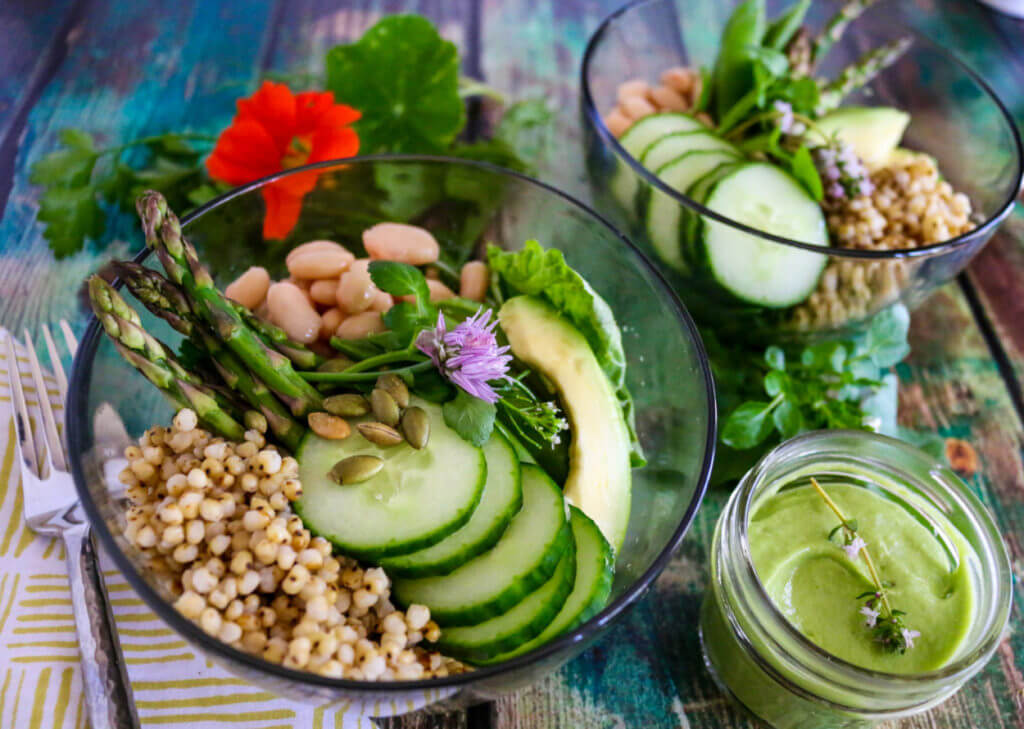
Biodiversity on the Plate
What does biodiversity on the plate look like? Essentially, a biodiverse plate has smaller portions of more diverse foods, including proteins, grains, and vegetables. However, our Western-style diets are anything but diverse; 12 plants and 5 animals account for 75% of our global food supply.4 It may seem impossible, given the thousands of products on supermarket shelves; yet, if you pay attention you’ll recognize those familiar plants and animal foods over and over, such as soy, corn, wheat, chicken, beef, and pork. Even in the produce section, you’ll find the same standard varieties, such as romaine lettuce, beefsteak tomatoes, and Spanish onions. It’s no wonder that diversity in our modern diets is an issue, as its simply not available to many.
Bioversity International5 outlines four key messages when it comes to promoting food biodiversity for healthy diets:
- Food biodiversity—the diversity of plants, animals and other organisms used for food, both cultivated and from the wild—is a critical element in response to global malnutrition, and it supports sustainable food systems.
- Food biodiversity reaches consumers through two principal pathways: (1) consumption via own production or gathering from the wild and (2) purchase of wild or cultivated species.
- The nutrient content between different species, or different varieties or breeds of the same species, can vary a thousand-fold. This information can be used to maximize the nutritional adequacy of diets.
- Improved availability, accessibility, affordability and acceptability of food biodiversity are key factors for achieving better diets.5
You’ll find examples of biodiverse diets all around us in traditional and indigenous diet patterns. “Indigenous diets are those which have been adapted to meet the specialized growing conditions of a specific eco-region. These foods work within planetary systems to provide sustenance for humans, while also giving back to the land in a regenerative fashion,” says Vogliano. These diet patterns often follow a simple formula: staples (grains, pulses) form the foundation—the canopy, if you will—for meals that are amplified with numerous plant and animal species and varieties. Think of rice dishes in countries in Asia, which are combined with a variety of vegetables, herbs, and animal proteins. Look to the pasta dishes in Italy, where they are carriers for numerous types of vegetables, herbs, spices, nuts, seeds, and proteins. In fact, people who eat rice and pasta regularly eat more vegetables, according to research.5
From spaghetti alla puttanesca to Vietnamese soups to Middle Eastern grain salads, there are many classic examples of biodiversity on the plate in traditional diet patterns, where a variety of wild and cultivated foods are worked into foodways. Biodiversity in diets is based on the old principle of “making something of nothing”. Foraging for “free” food, such as greens, mushrooms, fruits, nuts, herbs (even insects, small game, moss and ferns) in the wild. Planting backyard kitchen gardens, saving seeds, and sharing or trading foods among neighbors—thus cultivating hundreds and thousands of varieties over time. Growing rotation crops, such as legumes, which could also be harvested and eaten. Using the whole part of the plant—from stem to leaf; and animal—from nose to tail. Preserving foods to last over the lean times, thus enriching diversity of diets during the off season.
“Our dietary patterns are about so much more than food. Sustainable diets are diets with low environmental impacts that play an important role in ensuring food and nutrition security. Plants and animals that are adapted to the conditions of a specific place are less likely to need extra water, or shade, or season extension. So, eating from your place has less environmental impact,” says Currey. “Historically, our diet patterns evolved with our place. The Mediterranean Diet emerged in the Mediterranean region, which has a particular climate that supports particular plant, animal and aquatic communities that people decided they could eat. Religious beliefs influence eating habits as do cultural norms. But when indigenous people are removed from their places due to colonization, conflict, land grabbing, or other forms of cultural disruption, diets are also disrupted. Food plants can be lost or ingredients not available for traditional recipes.”
Preserving Biodiversity
A growing body of literature shows increases in agricultural diversity are linked with dietary diversity. Agricultural diversity refers to species and varieties, such as crops, animals, insects, and microorganisms, that are used directly or indirectly for food and agriculture in the range of ecosystems where agriculture is practiced, says Currey. She explains that agricultural diversity is linked with nutrient content, at the species level, as well as at the varietal level. Currey offers the example of peppers and broccoli. Peppers can be higher in vitamins C and A, but lower in vitamin K than broccoli. However, if we eat many different species (such as peppers and broccoli) and many different varieties of each species (such as red bell, poblano, and serrano peppers, and broccoli raab or Italian broccoli), we are more likely to achieve micronutrient adequacy in our diets because nutrient content varies.
The plain truth is, if we eat it, they will grow it. “If we are only demanding rice, corn, wheat, beef, chicken, some broccoli, carrots and iceberg lettuce, then farmers’ seeking living wages will have to grow what we, as consumers, are demanding. This leads to the simplification of our agricultural systems—more farmers growing or raising large amounts of just a few species and varieties. If we, as consumers, are demanding many species and many varieties, then farmers’ seeking living wages will want to grow what we want, giving them the opportunity to diversify their own production systems,” says Currey.
One way to preserve genetic diversity in our diets is through collecting seeds. More than 1,700 gene banks around the world are holding collections of food crops for safekeeping. For example, the Svalbard Global Seed Vault is a long-term seed storage facility deep inside a mountain on a remote island between Norway and the North Pole. The Ark of Taste, a program of Slow Food, is a living catalog of foods that are facing extinction.6 Their goal is to inspire people to take action by rediscovering thousands of threatened foods, from Heart Abjosh Raisins from Afghanistan to Spider Flower Leaves from Zimbabwe, by putting them back on the table so they are preserved forever.
A key strategy for increasing biodiversity is to support direct-to-consumer food purchases, such as farmers markets or CSAs (community supported agriculture) from local, biodiverse farms. This is often the primary way consumers, especially in cities, may have access to more diverse foods, such as different animal species and vegetable species and varieties. You might never have seen a Romanesco cauliflower or kohlrabi without visiting a farmers market, as these less common vegetables often aren’t worth stocking in supermarkets. Both farmers markets and CSAs, in which consumers purchase a share (or box) of the harvest from a local farm, are linked with better food quality. CSAs can encourage diversity in diets, as people are forced to use vegetables they might not have selected—CSA members report increased consumption of a variety of fruits and vegetables.7
Home gardening is one of the best ways to increase diversity in diets, improve human nutrition, and provide greater food access. A meta-analysis on gardening effects found a wide range of health outcomes, such as reductions in depression, anxiety, and BMI, and increases in life satisfaction, quality of life, and sense of community.8 Home gardening can also increase food security and dietary diversity in many different settings.9 What about ways to access this strategy in urban settings, where access to land is less available? Urban gardens, school gardens, and community gardens can help fill that need, offering opportunities for the community to learn about growing food, eating more healthfully, and living more sustainably.10
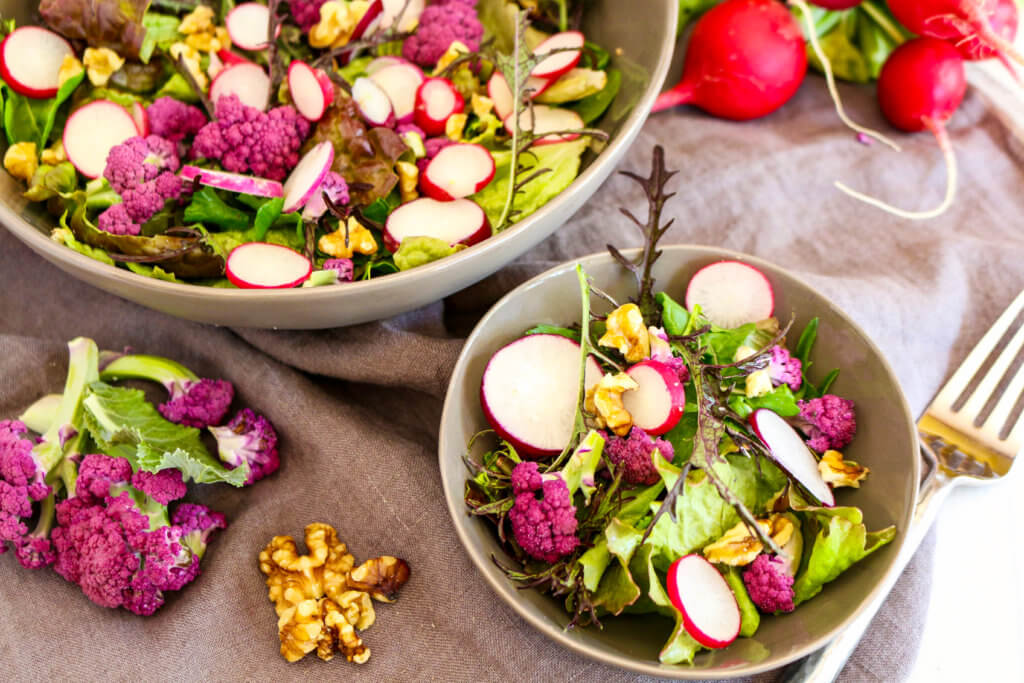
Protecting Biodiversity on Earth
While we certainly want a nutritionally diverse diet for human health, it is clear that it must not be produced at the risk of further harming the planet. This means we must feed humanity on the existing agricultural lands we have, not by deforesting our diverse ecosystems in order to support the human race. The “Half Earth” strategy for biodiversity conservation suggests conserving at least 80% of preindustrial species richness by protecting the remaining 50% of Earth’s intact ecosystems.1 This also includes managing the world’s oceans to make sure that aquaculture doesn’t harm habitats.1 However, it will take our most ambitious action plans to protect loss of biodiversity on the planet.1
“Westernized diets have encouraged the decline of many of the ecosystem services once provided by a wide range of biodiversity, with monoculture crops such as corn, soy, or wheat. Northwest Ohio once housed ‘The Great Black Swamp’ covering over 1500 square miles of terrain. Swamps serve as one of the most important ecosystems on Earth and provide habitat for an incredible number of plant and animal species. However, this swamp was drained centuries ago to make room for monoculture corn as far as the eye can see,” says Vogliano.
Purdy adds that the destruction of habitats is also due to deforestation to grow crops for animal feed and house livestock, as well as reliance on chemical fertilizers and pesticides which affect the habitats of the surrounding wildlife and the microbial ecosystem of the soil. Purdy says, “Genetic diversity is what helps plants maintain resilience and supports the ability to fend off disease and other unwanted adversities.”
In contrast, indigenous foods are often grown using more regenerative agricultural practices, which are in harmony with nature rather than against it, says Purdy. “This means fewer pesticides, less fertilizer and reduced reliance on monocultures. Their traditional farming methods often use more eco-friendly techniques that actually help to regenerate the soil, like using cover crops, manure and compost, and planting crops together which work symbiotically with one another, the classic example being the “3 Sisters”, corn, beans and squash.”

Tips for Eating a Diverse Diet
Currey offers the following tips to share with your clients for promoting biodiversity on the plate.
- Aim for colorful meals. Eating something red, purple, green, orange and yellow at every meal or through the day ensures that you are eating a diversity of plants and getting the micronutrients that you need!
- Try a new variety. The more varieties you eat, the more agrobiodiversity you support, providing farmers with more flexibility in their planting plans.
- Think about species diversity and food groups. Did you eat any nuts or seeds today? What about something yellow or orange? What about dark leafy greens? Whole grain starch? Dairy, eggs, and lean meat (for non-vegetarians)?
- Join a CSA. CSA’s work on a model where a member receives a portion of the yield that is ripe from the farmer each week in season. The research shows that CSA box recipients eat more species and varietal diversity, supporting biodiverse farmers.
References:
- Summary of the Commission Food in the Anthropocene: The Eat-Lancet Commission on Healthy Diets from Sustainable Food Systems. EAT-Lancet Commission. https://eatforum.org/content/uploads/2019/07/EAT-Lancet_Commission_Summary_Report.pdf. Published 2019.
- Burlingame, B., & Dernini, S. Sustainable Diets and Biodiversity: Directions and Solutions for Policy, Research, and Action. FAO. http://www.fao.org/3/a-i3004e.pdf. Published 2010.
- UN Report: Nature’s Dangerous Decline ‘Unprecedented’; Species Extinction Rates ‘Accelerating’ – United Nations Sustainable Development. United Nations. https://www.un.org/sustainabledevelopment/blog/2019/05/nature-decline-unprecedented-report/. Published 2019.
- McCarthy, K. Eating Biodiversity. https://www.thersa.org/discover/publications-and-articles/rsa-blogs/2018/12/eating-biodiversity. Published December 2018.
- Kennedy, G., Stolan, D., Hunter, D., Kikutwe, E., & Termote, C. Food biodiversity for healthy, diverse diets. Biodiversity International. https://www.bioversityinternational.org/fileadmin/user_upload/online_library/Mainstreaming_Agrobiodiversity/2_Food_Biodiversity_Healthy_Diets.pdf.
- Ark of Taste. Slow Food USA. https://slowfoodusa.org/ark-of-taste/. Published 2020.
- Vasquez, A., Sherwood, N. E., Larson, N., & Story, M. Community-Supported Agriculture as a Dietary and Health Improvement Strategy: A Narrative Review. Journal of the Academy of Nutrition and Dietetics, 117(1), 83–94. doi: 10.1016/j.jand.2016.09.029. Published 2017.
- Soga, M., Gaston, K. J., & Yamaura, Y. Gardening is beneficial for health: A meta-analysis. Preventive Medicine Reports, 5, 92–99. doi: 10.1016/j.pmedr.2016.11.007. Published 2017.
- Rammohan, B., Pritchard, B., & Dibley, M. Home gardens as a predictor of enhanced dietary diversity and food security in rural Myanmar. BMC Public Health. 19(1145). https://bmcpublichealth.biomedcentral.com/articles/10.1186/s12889-019-7440-7#citeas. Published 2019.
- Urban gardens promote education, nutrition, and more. USDA. https://www.usda.gov/media/blog/2015/10/28/urban-gardens-promote-education-nutrition-and-more. Published February 2017.
Main image: Harvest Grain Bowl, featured in Sharon’s upcoming book California Vegan.
For other blogs on sustainable eating, check out the following:
Green Up Your Kitchen Practices for a Healthier Planet
4 Ways to Eat for the Environment
Make the Most of Your Farmers Market


